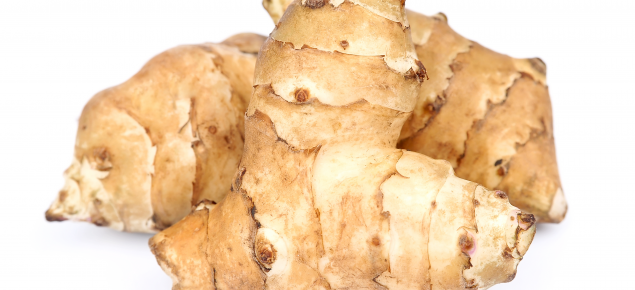Introduction
The Jerusalem artichoke (Helianthus tuberosus) belongs to the large Compositae family which also includes lettuces, sunflowers and globe artichokes. It is a native of North America.
The plant grows to a height of 2 to 3m and 0.6m wide. It resembles a sunflower, but produces a large number of edible knobbly tubers, which resemble ginger. The tubers are smaller, sweeter, crisper and nuttier than potatoes.
The Jerusalem artichoke should not be confused with globe artichoke, which is grown for its edible immature flowers.
Climate and soils
The Jerusalem artichoke is a spring and summer growing plant suited to southern Western Australia. Crops planted between September and November usually give the best yield and harvesting usually takes place between March and May.
Frosts cause severe damage to young plants which require around 140 frost-free days to produce good crops. When plants have died down, frosts may improve the flavour of mature tubers in the ground.
Loams or well fertilised slightly acid to neutral sandy soils, are preferred.
Management
White, red or purple-skinned varieties are available, with mainly unnamed white-skinned and white-fleshed varieties grown in Western Australia.
Jerusalem artichokes are propagated from tubers. Select plump tubers weighing about 70g and cut them up into setts. Each sett should have two to three eyes. Plant the setts 10cm deep and 30cm apart in ridges 75 to 100cm apart. The plants are hardy, and once established need little attention.
They are normally grown in full sun but will yield satisfactorily in more shaded locations than most other vegetables.
Fertiliser
On sandy soils, apply 50 cubic metres of compost per hectare in the rotation or before planting. This supplies organic matter, adds nutrients and helps retain moisture in the soil.
Apply the following rates of magnesium and trace elements before planting:
- 50kg/ha magnesium sulphate to supply magnesium
- 20kg/ha manganese sulphate to supply manganese
- 18kg/ha borax to supply boron
- 18kg/ha iron sulphate to supply iron
- 18kg/ha copper sulphate to supply copper
- 18kg/ha zinc sulphate to supply zinc
- 2kg/ha sodium molybdate to supply molybdenum.
Starting two weeks after emergence, topdress with a compound NPK fertiliser of around 12% nitrogen, 5% phosphorus and 14% potassium plus trace elements at rates of 200–300kg/ha every 14 days on infertile sandy soils, commencing with the lower rate.
The suggested fertiliser program is for a soil of low fertility. Test soil for phosphorus and irrigation water for nitrogen, phosphorus and potassium before planting.
Some phosphorus will be retained in sandy soils with a yellow or brown surface colour but not in grey or white sands. Some nutrients may be omitted or reduced if they are sufficiently high in the irrigation water and soil, or from compost and fertilisers from previous cropping.
Irrigation, pests, diseases and weeds
Daily irrigation will be required on free-draining sandy soils at rates that at least replace daily evaporation. Sprinkler or drip irrigation is suitable but sprinkler standpipes will need to be at least 2m high. If using drip irrigation, there should be at least two drippers per plant either side of the main stem.
Comprehensive information on the principles of irrigating vegetable crops in WA can be found on the vegetablesWA website.
Jerusalem artichokes are slightly affected by caterpillars, nematodes, slugs and two-spotted mites.
Stored tubers may be affected by dry rot.
Cultivate between rows to control weeds when plants are young. The last cultivation should be before the plants are 1m high. At this stage, the tubers begin to form around the base of the plant and must not be disturbed. Artichoke plants will shade out most weeds from this stage to maturity.
The registration and availability of chemicals for pest, disease and weed control changes regularly. Consult a trained and experienced horticultural agronomist or the Australian Pesticides and Veterinary Medicines Authority (APVMA) website for chemicals which are currently registered or have a permit for use on this crop.
The information on the label or permit for a chemical must be followed, including the directions for use, critical use comments, withholding period and maximum residue limit. Quality assurance schemes for horticultural crop production require producers to have current information on chemical registrations and permits readily available.
Harvesting and use
Harvesting
Jerusalem artichokes are usually harvested five to six months from planting.
Do not dig the crop until the tops die as yields increase up to this stage and immature tubers do not keep well. Slash the tops to facilitate harvesting. Handle the tubers with care as the skin is thin and easily bruised.
Tubers larger than 80g are suitable for marketing. They should be marketed fresh which usually requires progressive digging over a period of weeks to keep the market adequately supplied. Wash them gently to remove excess soil before packing without free moisture in ventilated plastic bags, net bags or plastic crates.
If necessary, mature tubers can be stored in sawdust, dry sand or chaff. They may also be stored for three months at 0°C in a coolstore with high relative humidity. Dehydration can occur in tubers exposed directly to air and rots can develop if tubers are damaged in the digging and washing process and kept wet.
Yields can be up to 80t/ha.
Jerusalem artichokes can be grown as a perennial crop and may be kept in the same position for up to five years. Commercial crops are usually removed in autumn and replanted in a different area in spring.
Cooking
Jerusalem artichokes are a good source of fibre, iron and vitamin B, and a good food for diabetics.
Tubers are washed and scrubbed or peeled then boiled until cooked. They may also be baked after boiling for a few minutes and also make a pleasant and interesting soup. Combining them with other vegetables such as onions and tomatoes can also provide an interesting dish.
Acknowledgement
The original content of this page was written by Harry Gratte and John Burt.

